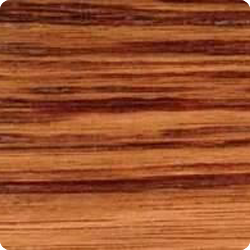Detailed Specs: Wallaba
Scientific Name: Eperua falcata
Family: Caesalpiniaceae
Other Names: Palo machete (Venzuela), Bijlhout (Suriname), Wapa (French Guinana), Apa, Apazeiro, Jebaro (Brazil)
The Tree
The bole is straight and cylindrical and clear up to 40-60 feet and the diameter is approximately 60cm and occasionally reaches u to cm and grows from 80-90 feet high.
The Wood
General Characteristics: The heartwood is light to dark red to reddish or purplish brown with a distinctive dark gummy streaks which tend to spread over the surface. The sapwood is pale and is sharply defined from the heartwood. The texture is coarse and the grain is typically straight.
Weight: Basic specific gravity (oven dry weight/green volume) 0.78; air dry density 58 pcf.
Drying and Shrinkage: The wood dries very slowly with a tendency to check, split, and warp, also honeycomb may develop in thick material. Kiln schedule T2-C2 is suggested for 4/4 stock and T2-C1 for 8/4. Air drying should precede kiln drying. Shrinkage green to ovendry: radial 3.6%; tangential 6.9%; volumetric 10.0%.
Working Properties: Although the wood has high density, it is easy to work with both hand and machine tools, however, high gum exudate clogs saw teeth and cutters. Once kiln dried, gum exudates are not a serious problem in machining. It glues and polishes well.
Mechanical Properties: (2cm standard).
|
Moisture |
Bending Strength (psi) |
Modules of Elasticity (1000 psi) |
Maximum Crushing Strength (psi) |
| Green (42)
12% |
15,100
20,200 |
2,180
2,130 |
8,380 11,210 |
Durability: Heartwood is reported to be durable, resistant to subterranean termites and fairly resistant to dry wood termites, however, to marine borers is low. Wallaba is self-impregnated by nature thus creosoting is unnecessary.
Distribution: It is abundant in Guyana’s forest and is regularly supplied in large volumes. It also extends to Venezuela and the Amazon region of northern Brazil. It generally occurs in the pure stands or as dominants, mostly on acid white and sandy soils. It i s also common in creek valleys and in the high savannah forest.
Preservation: Extremely resistant to preservation treatments.
Uses: Wallaba has excellent qualities for transmission poles, flag staffs, marine and bridge construction in non -teredo areas owing to its strength and durability. It is also well suited for general heavy construction, utility and industrial floors and chemical vat staves. Additionally the timber can be used to make fence staves, posts and shingles for roofing.
References
– Chundnoff, Martin (1984), “Tropical Timbers of the World.” USDA Forest Service Ag. Handbook No.607.



